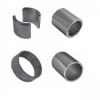Cerium seemed the least likely element to solve the problem of creating cheap
rare earth magnets, because it tarnishes easily, reacts with water, and burns when heated. Scientists at the
U.S. Department of Energy’s Ames Laboratory, however, found a way to use cerium instead of dysprosium in high-performance magnets. They added small amounts of cerium and cobalt together to create an alloy superior to the dysprosium-containing alloy commonly used for high-performance permanent magnets.
The rare earth metal, cerium, is readily available and inexpensive, making it a desirable alternative to dysprosium.
Dysprosium, one of the main components in an alloy for high-performance magnets, is resistant to demagnetization at high temperatures. This makes it useful for engines and generators such as those used in vehicles and wind turbines.
Rare-Earth Magnets and Green Technology
This discovery arrives just after a
report released by Allied Market Research stating that the Global Permanent Magnet Motor Market will reach $45.3 billion by 2020. Due to the growth of green technologies, rare earth magnets are becoming more and more prevalent in consumer products from cell phones to cars.
How Are Magnets Used in Motors?
Because of the way the poles of a magnet interact with each other by repelling and attracting, when placed in a motor they rotate. Usually, a wire coil surrounds a permanent magnet. When electricity passes through the coil it is magnetized and becomes an electromagnet. The electromagnet is then attracted to the permanent magnet and
causes the motor to rotate.
Some
magnet motors are very small such as the ones used in toy cars. Others are large enough to move a car or rotate a wind turbine. This discovery, an alloy made of neodymium, iron and boron co-doped with cobalt and cerium, will likely help reduce manufacturing costs of large motor magnets used for automobiles and wind turbines. From November 2014 to February 2015, the price of dysprosium jumped by
over 20 percent, making the cerium-based alloy 20 to 40 percent cheaper.
Permanent magnet motors demonstrate a superior performance and save energy by
reducing field excitation losses. In addition to their green tech benefits, rare earth magnets also act as the key behind the miniaturization of phones, tablets, and other devices.
As the leading manufacturer of permanent magnet motors, China exercises a monopoly over the rare-earth element industry.
60 Minutes recently focused on the use of rare earth elements driving the green tech industry as well as China’s role in a
blog post.
“Today, China is on top not only because it has the biggest mine and the most know-how, but also as a result of having drawn manufacturers from around the world that use rare earths (i.e. supply chain customers) to Asia.”
It’s too soon to tell what this discovery will mean for the motor magnet industry in China. As the green tech industry grows, so do the possibilities for rare earth magnets and neodymium magnets.

